1994 CHEVROLET CAVALIER belt
[x] Cancel search: beltPage 7 of 243
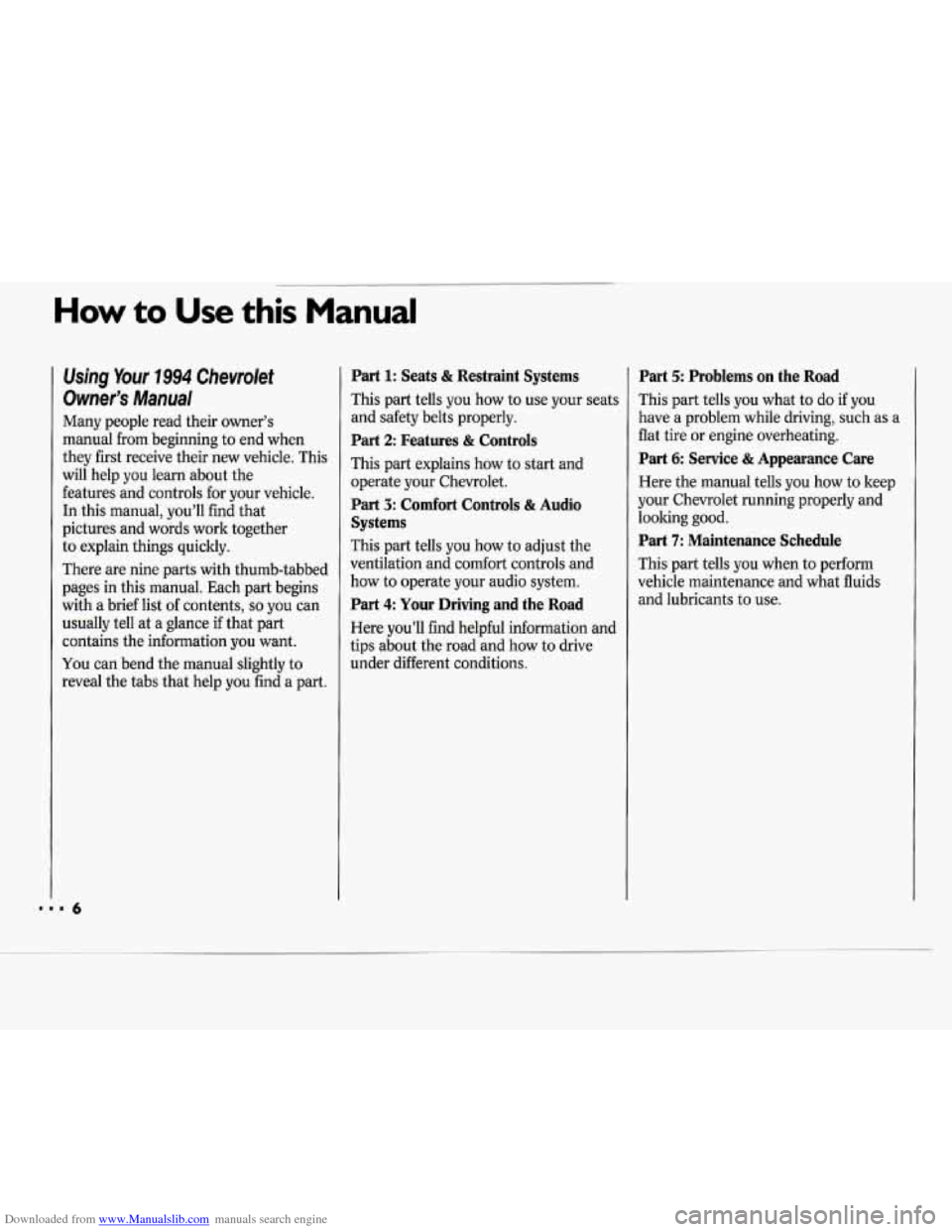
Downloaded from www.Manualslib.com manuals search engine Using Your 7994 Chevrolet
Owner’s Manual
Many people read their owner’s
manual
from beginning to end when
they first receive their new vehicle. This
will help you learn about the
features and controls for your vehicle.
In this manual, you’ll find that
pictures and words work together
to explain things quickly.
There are nine parts with thumb-tabbed
pages in this manual. Each part begins
with a brief list of contents,
so you can
usually tell at a glance if that part
contains the information you want.
You can bend the manual slightly to
reveal the tabs that help you find a part.
Part 1: Seats & Restraint Systems
This part tells you how to use your seats
and safety belts properly.
Part 2 Features & Controls
This part explains how to start and
operate your Chevrolet
.
Part 3: Comfort Controls & Audio
Systems
This part tells you how to adjust the
ventilation and comfort controls and
how to operate your audio system.
Part 4 Your Driving and the Road
Here you’ll find helpful information and
tips about the road and how
to drive
under different conditions.
Part 5: Problems on the Road
This part tells you what to do if you
have a problem while driving, such as a
flat tire or engine overheating.
Part 6: Service & Appearance Care
Here the manual tells you how to keep
your Chevrolet running properly and
looking good.
Part 7: Maintenance Schedule
This part tells you when to perform
vehicle maintenance and what fluids
and lubricants to use.
Page 10 of 243
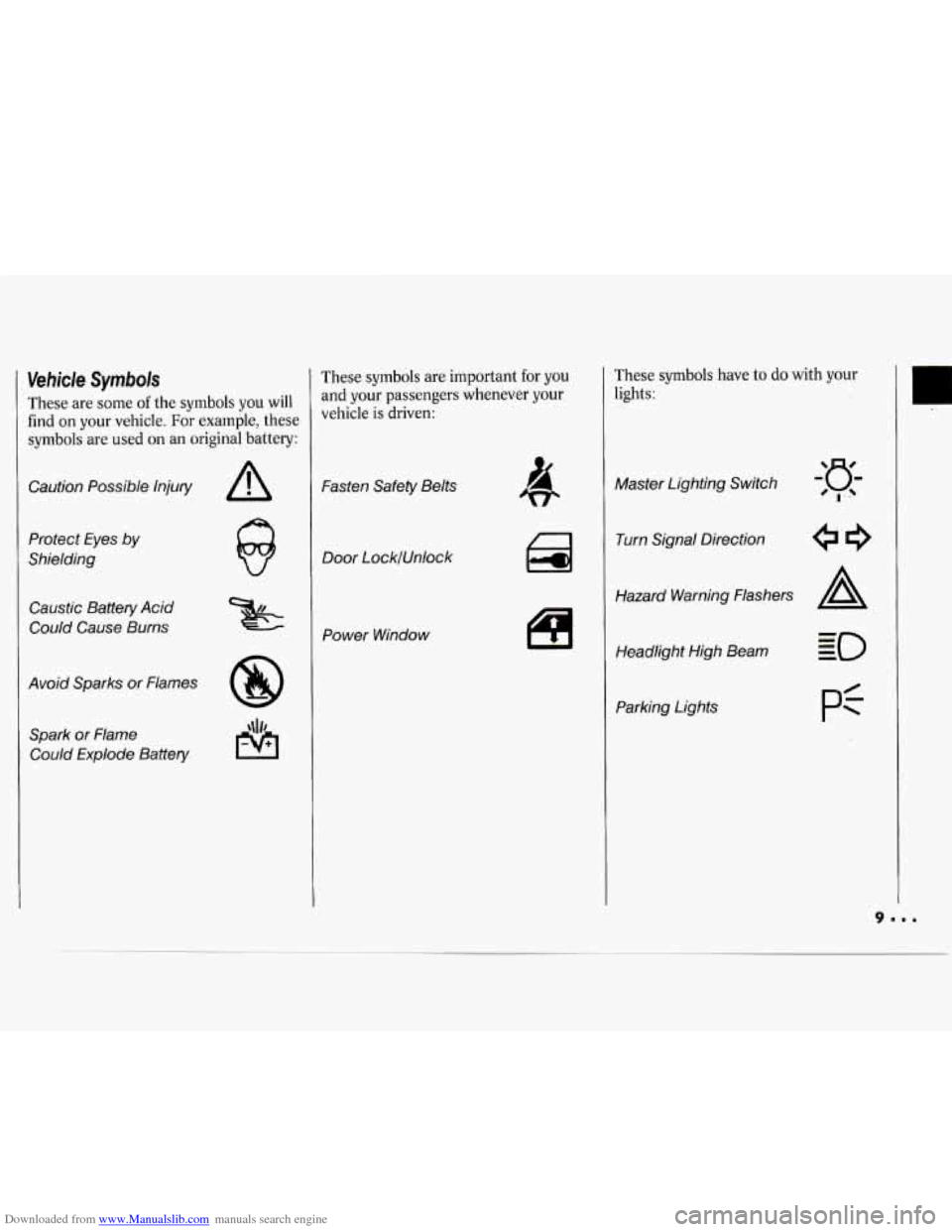
Downloaded from www.Manualslib.com manuals search engine Vehicle Symbols
These are some of the symbols you will
find
on your vehicle. For example, these
symbols are used on an original battery:
Caution Possible lnjuty
Protect Eyes
by
Shielding
Caustic Battery Acid
Could Cause Burns
Avoid Sparks or Flames Spark or Flame Could Explode Battery
These symbols are important for you
and your passengers whenever your
vehicle
is driven:
Fasten Safety Belts
Door LocklUnlock
Power Window
These symbols have to do with your
lights:
Master Lighting Switch
Turn Signal Direction
Hazard Warning Flashers
A
Headlight High Beam
Parking Lights
pf
U
Page 12 of 243
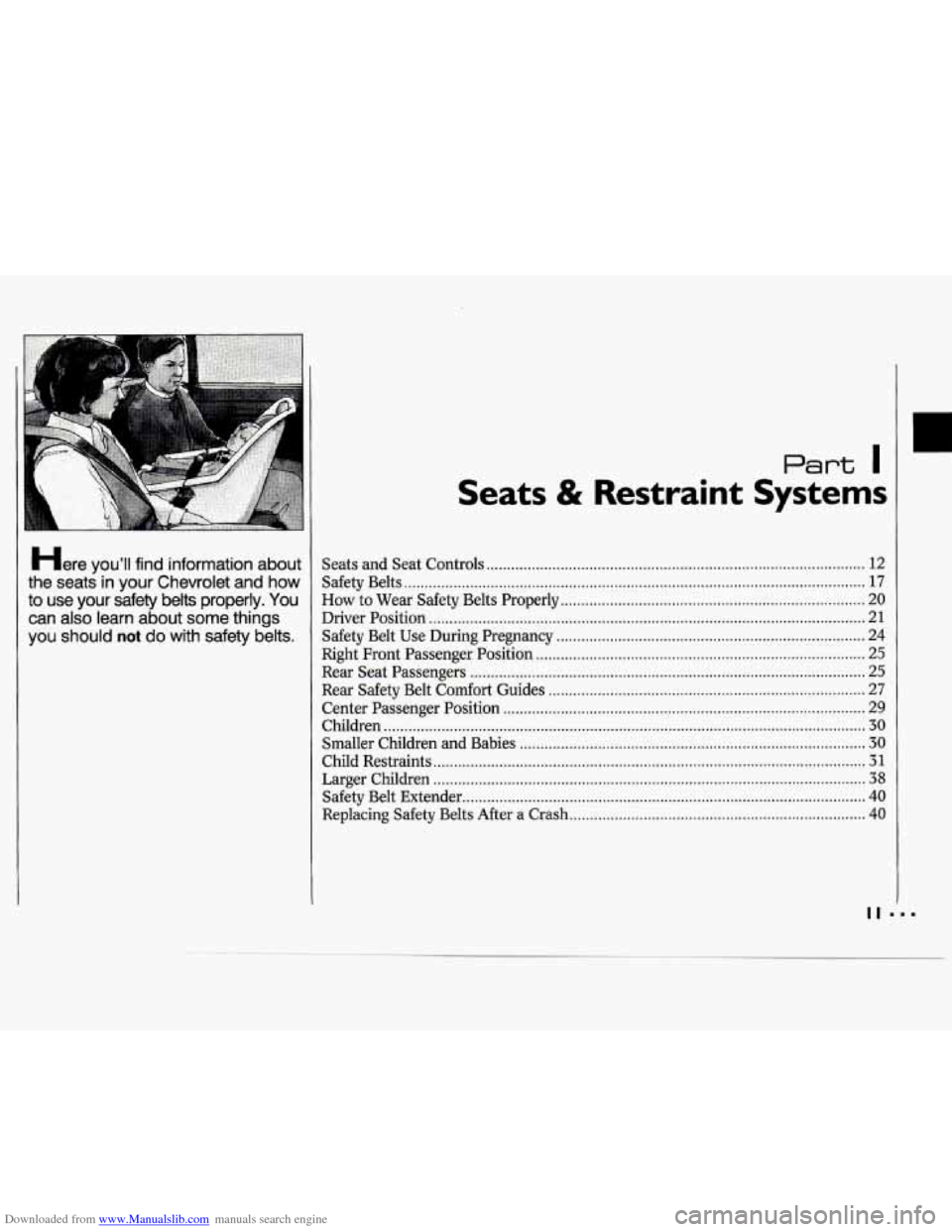
Downloaded from www.Manualslib.com manuals search engine Here YOU’II find information about
the seats
in your Chevrolet and how
to use your safety belts properly
. You
can also learn about some things
you should
not do with safety belts .
Part I
Seats & Restraint Systems
Seats and Seat Controls ........................................................................\
.................... 12
Safety Belts ........................................................................\
........................................ 17
Driver Position ........................................................................\
.................................. 21
Safety Belt Use During Pregnancy ........................................................................\
... 24
Rear Seat Passengers ........................................................................\
........................ 25
Rear Safety Belt Comfort Guides ........................................................................\
..... 27
Center Passenger Position ........................................................................\
................ 29
Children ........................................................................\
............................................. 30
Smaller Children and Babies ........................................................................\
............ 30
Child Restraints ........................................................................\
................................. 31
Larger Children ........................................................................\
................................. 38
Safety Belt Extender ........................................................................\
.......................... 40
Replacing Safety Belts After a Crash ........................................................................\
40
How to Wear Safety Belts Properly ........................................................................\
.. 20
Right Front Passenger Position ........................................................................\
........ 25
Page 16 of 243
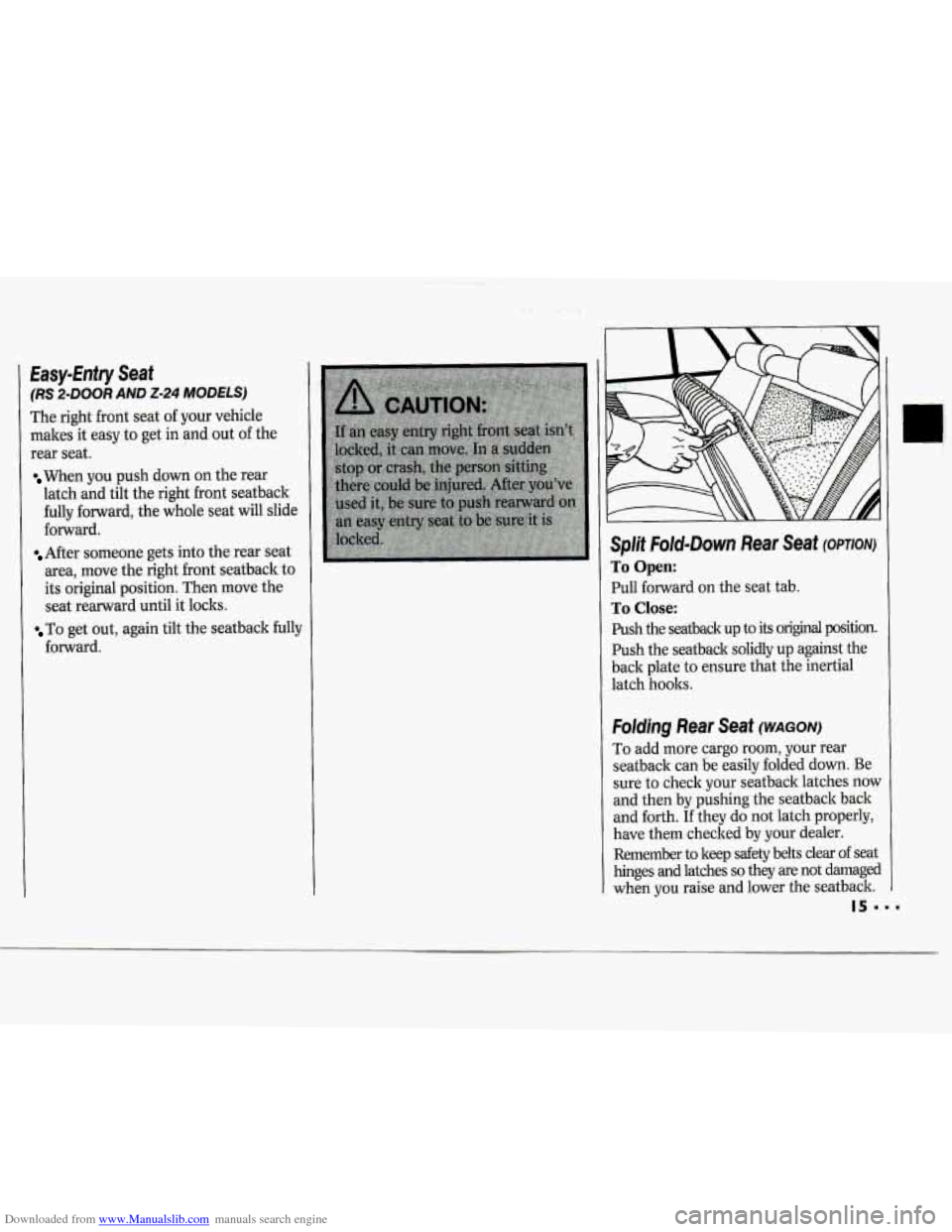
Downloaded from www.Manualslib.com manuals search engine Easy-Enfry Seaf
(RS 2-DOOR AND 2-24 MODELS)
The right front seat of your vehicle
makes it easy to get in and out of the
rear seat.
When you push down on the rear
latch and tilt the right front seatback
fully forward, the whole seat will slide
forward.
After someone gets into the rear seat
area, move the right front seatback to
its original position. Then move the
seat rearward until it locks.
To get out, again tilt the seatback fully
forward.
Splif Fold-Down Rear Seaf (OPTION)
To Open:
Pull forward on the seat tab.
To Close:
Push the seatback up to its original position.
Push the seatback solidly up against the
back plate to ensure that the inertial
latch hooks.
Folding Rear Seaf (WAGON)
To add more cargo room, your rear
seatback can be easily folded down. Be
sure to check your seatback latches now
and then by pushing the seatback back
and forth.
If they do not latch properly,
have them checked by your dealer.
Remember to keep safety belts clear
of seat
hinges and latches
so they are not damaged
when you raise and lower the seatback.
Page 18 of 243
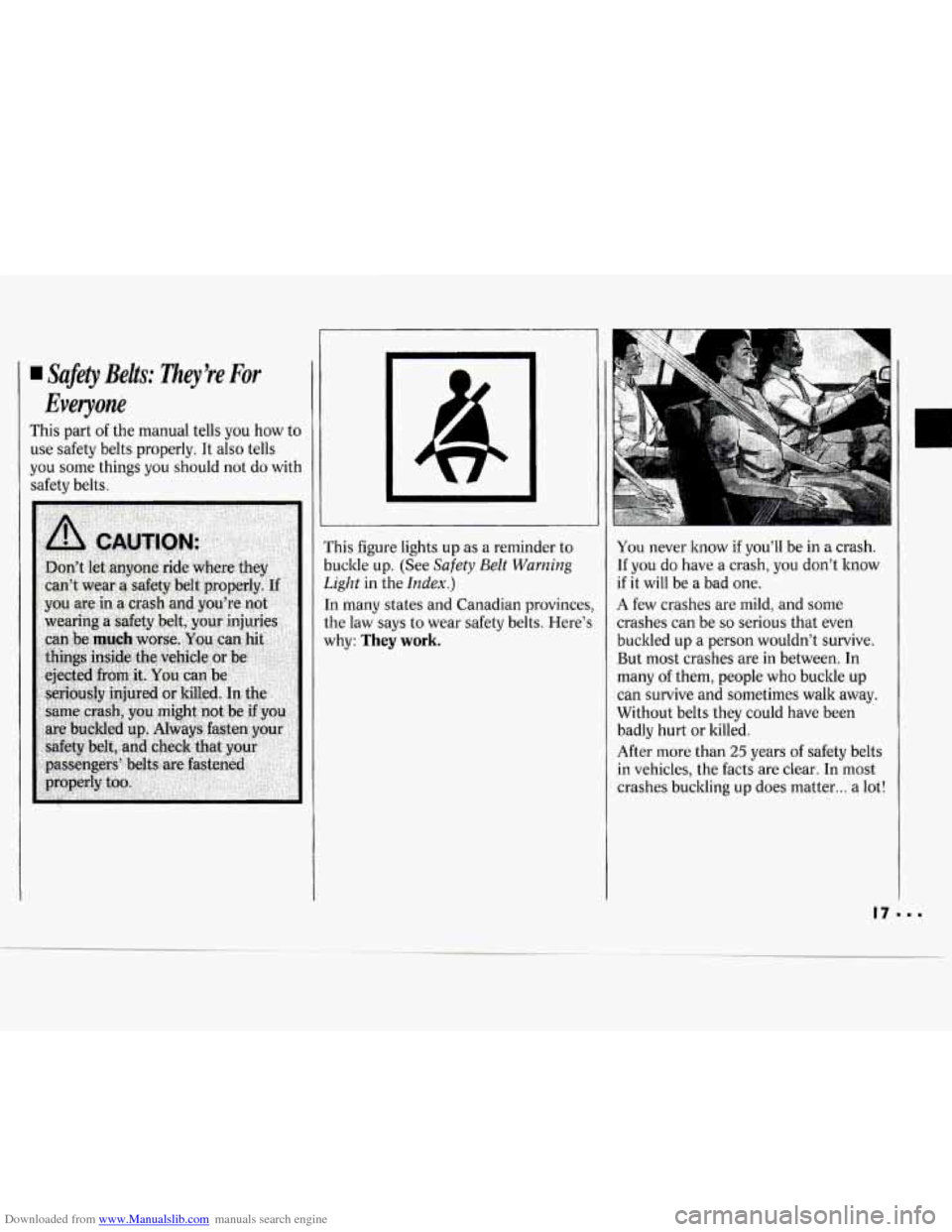
Downloaded from www.Manualslib.com manuals search engine Safety Belts: They’re For
Everyone
This part of the manual tells you how to
use safety belts properly. It also tells
you some things you should not
do with
safety belts.
This figure lights up as a reminder to
buckle up. (See
Safety Belt Warning
Light
in the Index.)
In many states and Canadian provinces,
the law says to wear safety belts. Here’s
why:
They work.
You never know if you’ll be in a crash.
If you do have a crash, you don’t know
if it will be a bad one.
A few crashes are mild, and some
crashes can be
so serious that even
buckled up a person wouldn’t survive.
But most crashes are in between. In
many of them, people who buckle up
can survive and sometimes walk away.
Without belts they could have been
badly hurt or killed.
After more than
25 years of safety belts
in vehicles, the facts are clear. In most
crashes buckling
up does matter ... a lot!
n
Page 19 of 243
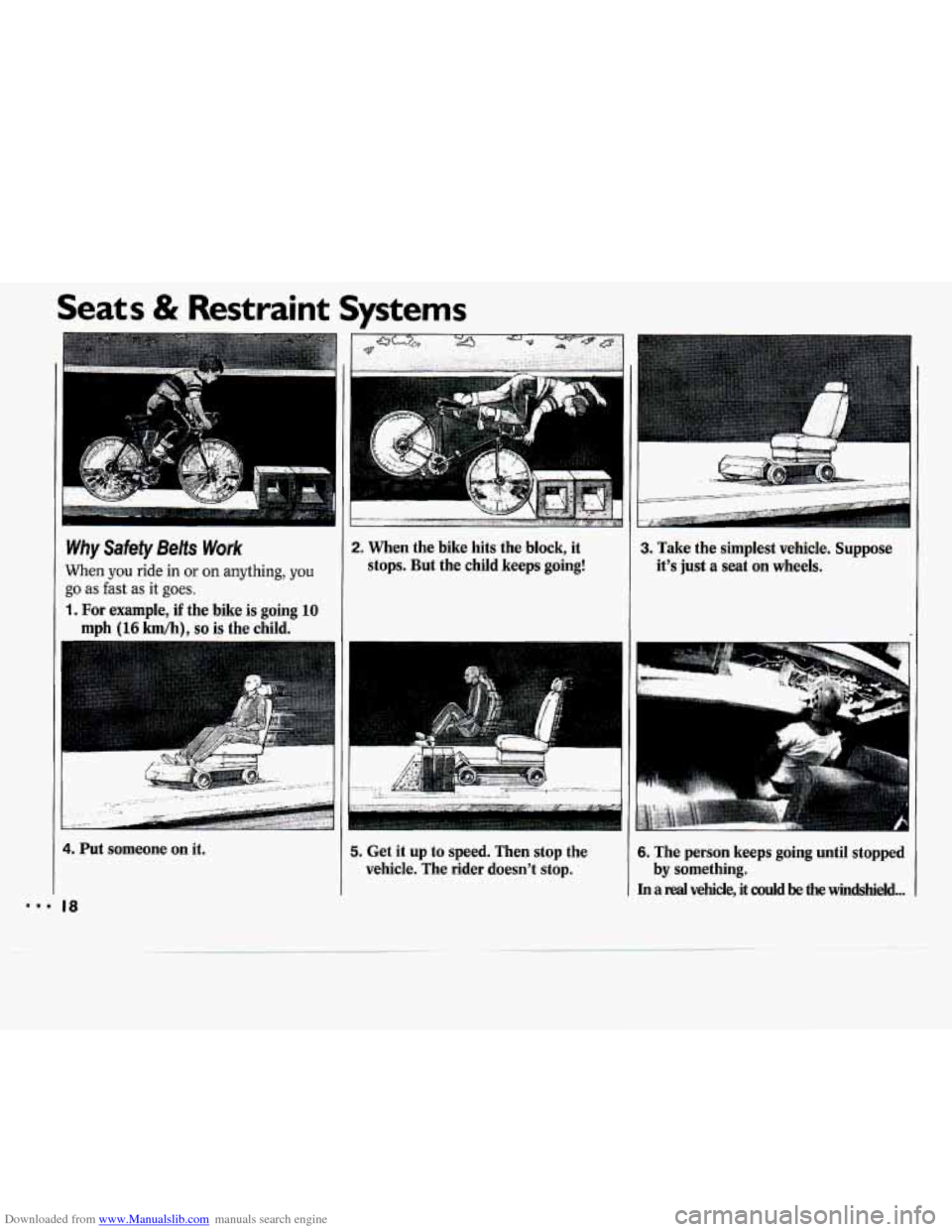
Downloaded from www.Manualslib.com manuals search engine Seats & Restraint Systems
2. When the bike hits the block, it
stops. But the child keeps going! Why Safety Belts Work
When you ride in or on anything, you
go as fast as it goes.
1. For example, if the bike is going 10
mph (16 km/h). so is the child.
3. Take the simplest vehicle. Suppose
it's just a seat on wheels.
4. Put someone on it.
'8. 18
5. Get it up to speed. Then stop the
vehicle. The rider doesn't stop. 6. The person keeps going until stopped
In a real vehicle, it could be the windshield ...
by something.
Page 20 of 243
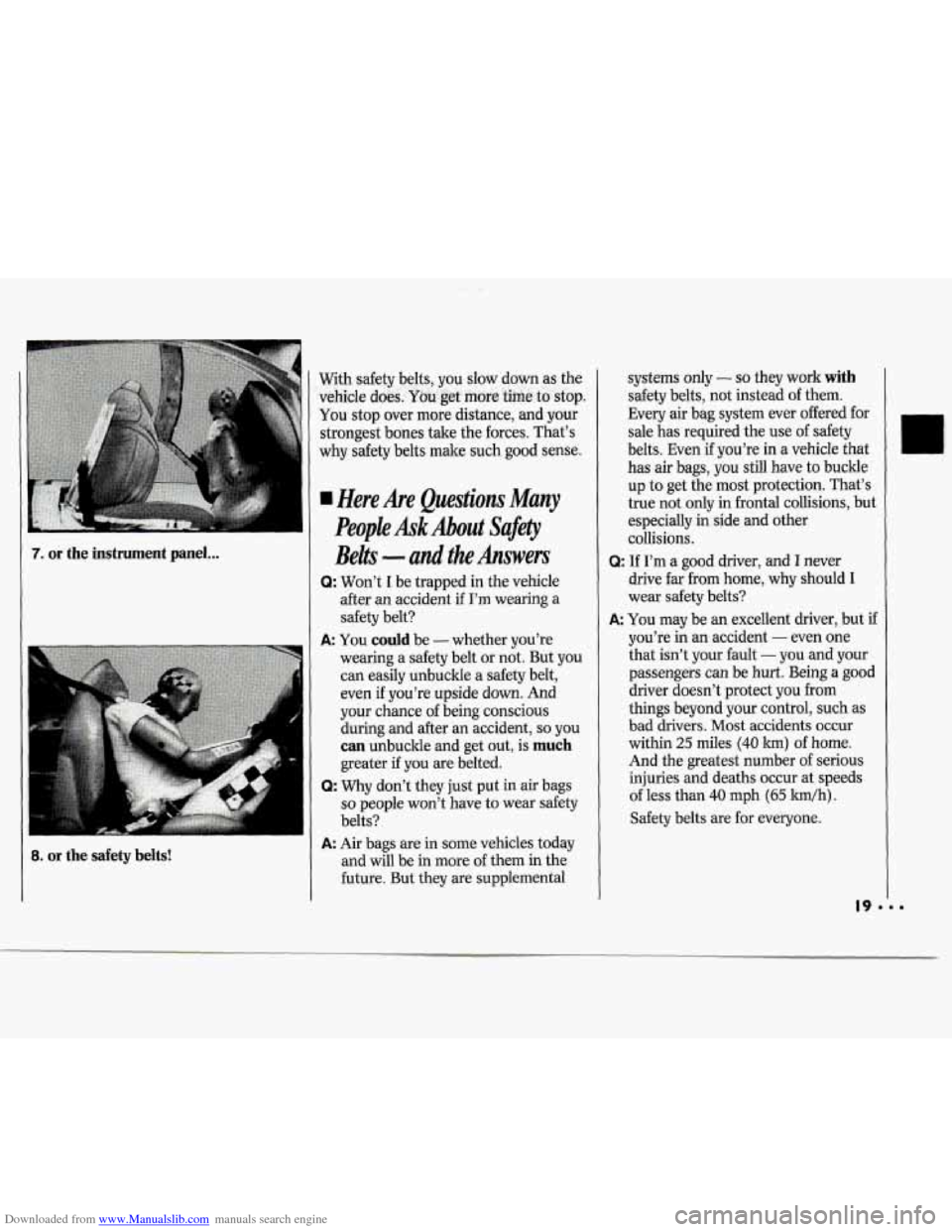
Downloaded from www.Manualslib.com manuals search engine 7. or the instrument panel ...
8. or the safety belts!
4
:”
With safety belts,. you slow down as the
You stop over more distance, and your
strongest bones take the forces. That’s
why safety belts make such good sense.
v6Kicle
d&~i;~&!&~ h&. ‘m&t&sQp,
HereAre Questions Many
People Ask About Safety
Belts
- and the Answers
Q: Won’t I be trapped in the vehicle
after
an accident if I’m wearing a
safety belt?
A: You could be -whether you’re
wearing a safety belt or not. But you
can easily unbuckle a safety belt,
even
if you’re upside down. And
your chance of being conscious
during and after an accident,
so you
can unbuckle and get out, is much
greater if you are belted.
Q: Why don’t they just put in air bags
so people won’t have to wear safety
belts?
A: Air bags are in some vehicles today
and will be
in more of them in the
future. But they are supplemental systems only
- so they work with
safety belts,
not instead of them.
Every
air bag system ever offered for
sale has required the use
of safety
belts. Even
if you’re in a vehicle that
has
air bags, you still have to buckle
up
to get the most protection. That’s
true not only
in frontal collisions, but
especially in side and other
collisions.
drive
far from home, why should I
wear safety belts?
A You may be an excellent driver, but if
you’re in an accident - even one
that isn’t your fault
- you and your
passengers can be
hurt. Being a good
driver doesn’t protect you from
things beyond your control, such as
bad drivers.
Most accidents occur
within
25 miles (40 km) of home.
And the greatest number
of serious
injuries and deaths occur at speeds
of less than
40 mph (65 lun/h).
Safety belts are for everyone.
Q: If I’m a good driver, and I never
I- I
Page 21 of 243
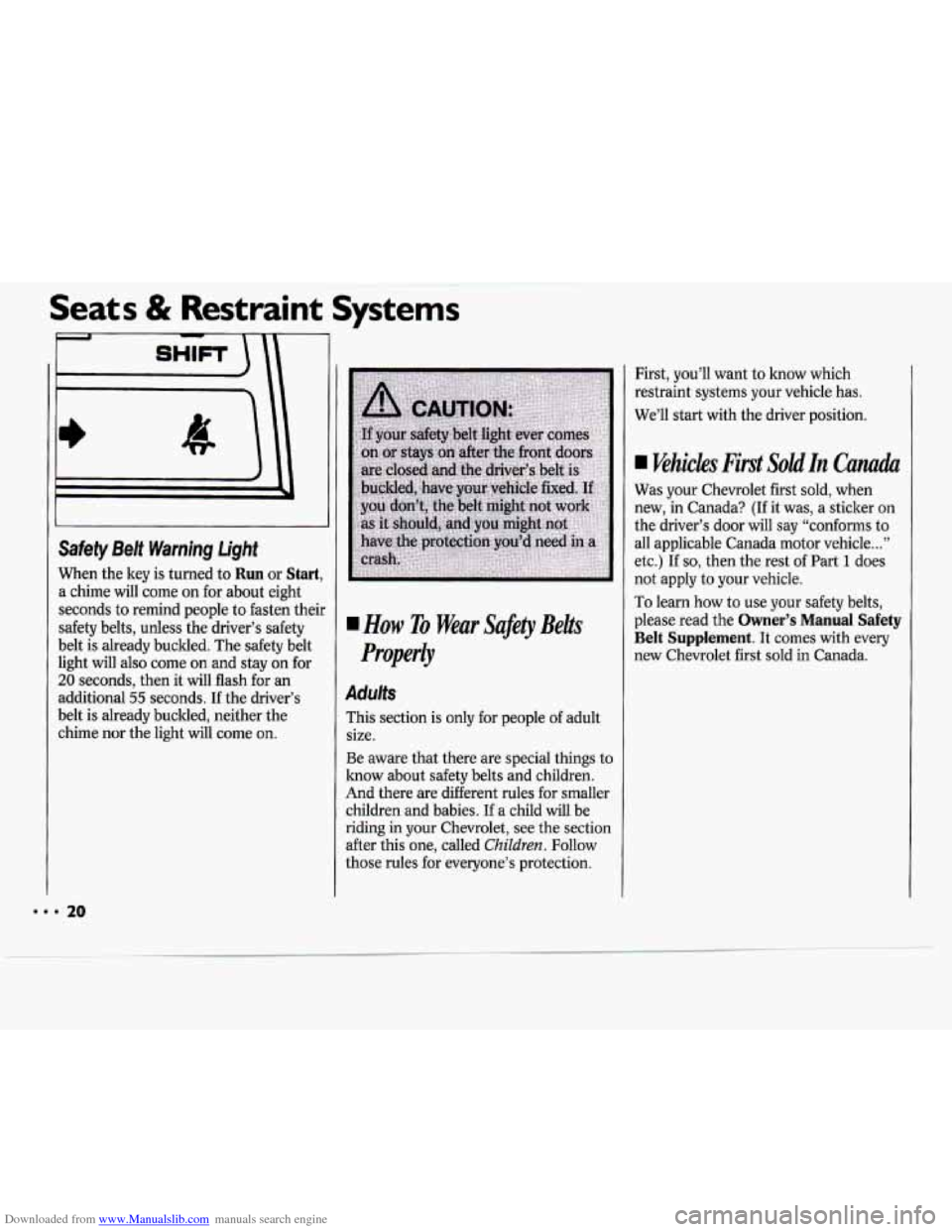
Downloaded from www.Manualslib.com manuals search engine ~~ Seats & Restraint Systc
Safety Belt Warning
light
When the key is turned to Run or Start,
a chime will come on for about eight
seconds to remind people to fasten their
safety belts, unless the driver’s safety
belt is already buckled. The safety belt
light will also come on and stay on for
20 seconds, then it will flash for an
additional
55 seconds. If the driver’s
belt is already buckled, neither the
chime nor the light will come on.
How To Wear Safety Belts
Properly
Adults
This section is only for people of adult
size.
Be aware that there are special things to
know about safety belts and children.
And there are different rules for smaller
children and babies.
If a child will be
riding in your Chevrolet, see the section
after this one, called
Children. Follow
those rules for everyone’s protection. First,
you’ll want
to know which
restraint systems your vehicle has.
We’ll start with the driver position.
Vehicles First SoldIn Canada
Was your Chevrolet first sold, when
new, in Canada?
(If it was, a sticker on
the driver’s door will say “conforms to
all applicable Canada motor vehicle
...”
etc.) If so, then the rest of Part 1 does
not apply to your vehicle.
To learn how to use your safety belts,
please read the
Owner’s Manual Safety
Belt Supplement. It comes with every
new Chevrolet first sold in Canada.
888 20